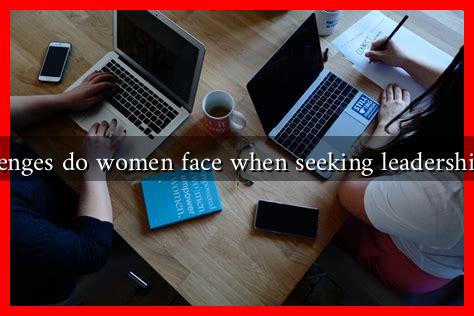-
Table of Contents
What Challenges Do Women Face When Seeking Leadership Positions?
Despite significant progress in gender equality over the past few decades, women continue to face numerous challenges when seeking leadership positions across various sectors. These challenges are deeply rooted in societal norms, organizational cultures, and systemic biases that often hinder women’s advancement. This article explores the multifaceted barriers women encounter and highlights the importance of addressing these issues to foster a more equitable workplace.
Societal Norms and Stereotypes
One of the most pervasive challenges women face is the societal norms and stereotypes that dictate what leadership should look like. Traditional views often associate leadership with masculine traits such as assertiveness and decisiveness, which can marginalize women who may exhibit different styles of leadership.
- Gender Stereotypes: Women are often perceived as less competent or less committed to their careers, especially if they have children. This stereotype can lead to biases in hiring and promotion decisions.
- Double Bind Dilemma: Women in leadership roles often face a double bind where they are criticized for being too aggressive if they display assertiveness, yet are seen as weak if they adopt a more collaborative approach.
Workplace Culture and Organizational Barriers
The culture within organizations can significantly impact women’s ability to ascend to leadership roles. Many workplaces still operate under outdated practices that do not support diversity and inclusion.
- Lack of Mentorship: Women often have fewer mentors and sponsors compared to their male counterparts. A study by McKinsey & Company found that women are less likely to receive advice and support from senior leaders, which is crucial for career advancement.
- Networking Opportunities: Networking is essential for career growth, yet women often find themselves excluded from informal networks that can lead to leadership opportunities.
- Work-Life Balance: The expectation for women to manage both professional and domestic responsibilities can create additional stress and limit their availability for leadership roles.
Systemic Bias and Discrimination
Systemic bias within organizations can manifest in various ways, making it difficult for women to break through the glass ceiling. Discrimination can be both overt and subtle, affecting hiring, promotions, and pay equity.
- Pay Gap: Women continue to earn less than men for the same roles. According to the World Economic Forum, the global gender pay gap is projected to take over 135 years to close, which directly impacts women’s financial independence and career aspirations.
- Performance Evaluations: Research shows that women often receive less favorable performance evaluations than men, even when their performance is comparable. This bias can hinder their chances of promotion.
Case Studies and Statistics
Several case studies illustrate the challenges women face in leadership. For instance, a report by Catalyst found that women hold only 29% of senior management roles globally. In the tech industry, women occupy only 25% of leadership positions, despite making up nearly half of the workforce. These statistics highlight the urgent need for organizations to implement strategies that promote gender equality.
Moreover, companies with more women in leadership roles tend to perform better financially. A study by Credit Suisse found that companies with at least one woman on the board had higher returns on equity compared to those with all-male boards. This correlation underscores the value of diverse leadership teams.
Conclusion
The challenges women face when seeking leadership positions are complex and multifaceted, rooted in societal norms, workplace culture, and systemic biases. Addressing these challenges requires a concerted effort from organizations to create inclusive environments that support women’s advancement. By implementing mentorship programs, promoting pay equity, and fostering a culture of diversity, organizations can help dismantle the barriers that hinder women’s leadership aspirations.
Ultimately, empowering women in leadership not only benefits individuals but also enhances organizational performance and drives innovation. As we move towards a more equitable future, it is crucial to recognize and address the challenges women face in leadership roles, paving the way for a more inclusive and diverse workforce.
For further reading on this topic, you can explore resources from organizations like Catalyst and McKinsey & Company.

